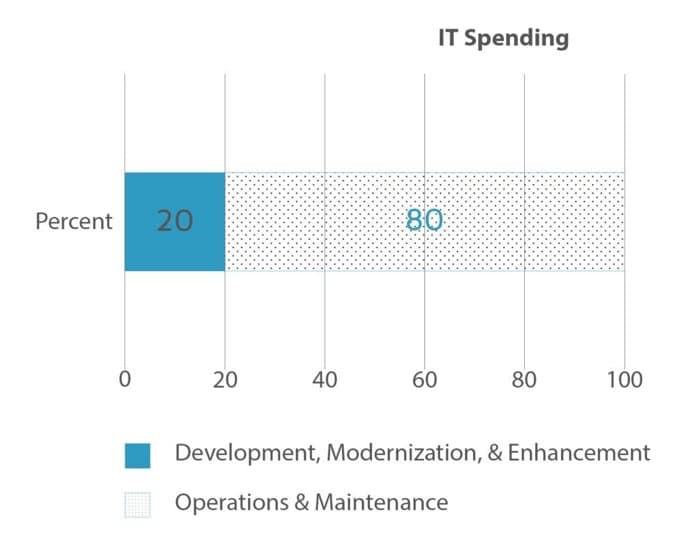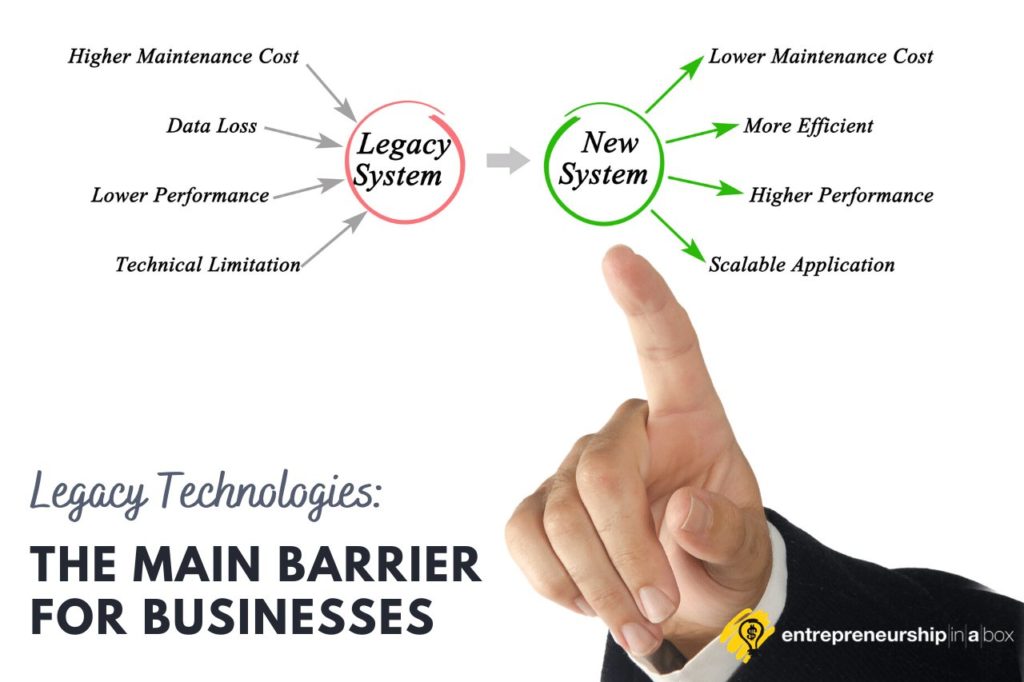We live in challenging times, both technologically and business-wise. It’s hard to keep up with all changes happening right now to maintain the competitive edge of your organization.
For some, that means simply letting the outdated hardware and software do their job while focusing on other areas. I have enough experience working with SPD Group, a reliable partner in dealing with legacy technologies, to say that legacy modernization is crucial for any organization.
Just take a look at the report by ACT, four years ago they had revealed that three-quarters of governmental maintenance funding was spent on supporting legacy systems in federal agencies. Even such giants as USA’s governmental organizations realize the real cost of legacy and make moves to improve the situation. Social Security Administration is planning to get rid of legacy software completely, according to this article.
Governmental organizations are very slow to change, sometimes it takes decades, and they don’t have competitors. But businesses do! Business leaders recognize the importance of having a modernization plan, as 9 of 10 of them believe that legacy systems are the main obstacle for business growth. In fact, you can forget about Cloud Infrastructure and innovations like Artificial Intelligence and Machine Learning if you’ll stick to old technologies. So what can you do to pick your legacy solution? This article will help you to get an idea!

What are legacy technologies?
Let’s go straight to the definition — we can consider a “legacy” a software or hardware that was used in the past, but already had been bested by a new version or model. Of course, the first you can think of is some ancient equipment, but age by itself isn’t a deciding factor here. The technology could be easily turned to legacy when the vendor releases a newer version of the software or go bankrupt and can no longer support the technology.
Windows XP is a standout among the examples of legacy systems. This operating system became an instant success, after its introduction at the dawn of the new millennium. Microsoft was supporting this OS for 13 years and introduced a number of newer versions by 2020.
We can classify Windows XP as a legacy at the moment when free Microsoft support ended in April 2014. At that moment it probably wasn’t considered very old, however, it is now. But that doesn’t stop companies from using it to this day. The main reason is the applications impossible to migrate to the latest version of Windows. What’s the cost of using Windows XP, you might ask? Well, I mentioned that free support had ended, it’s still possible to pay for security updates. That was exactly what the United Kingdom’s government ended up doing, paying nearly $10 million per year to Microsoft for keeping their XP’s alive. There are many more examples of legacy systems, but you got the point!
Why legacy technologies are limiting your business?
I believe the following are the main reasons you should start considering partial or complete modernization right now!
Maintenance issues
As you saw on Windows XP example — maintenance requires money. The older system gets, the harder it is to support. For smaller businesses, it could become critical for survival — legacy maintenance often requires up to 70% of the IT budget. Not only high costs are the factor, but it is also much more complex to fix things if you stick to legacy.
Lack of scalability
Your business is always evolving, but your legacy systems will limit you in some way with a growing demand for your product or services. Being unable to keep up with scaling scenarios is probably the biggest problem of legacy.
Modernization constraints
Avoiding legacy modernization, you are also avoiding the benefits that modern technologies like the Internet Of Things, Artificial Intelligence, Machine Learning, or AR provide. Older systems can be adjusted to work with some of them, but it will be much easier to introduce new infrastructure.
The inability for platform unification
Yes, you can’t ignore all the innovations, and probably you had used them already to some extent. If you did, you realize how hard it is to somehow connect the legacy platforms with new technologies — they don’t blend very well, sometimes don’t work together at all. In this case, you miss an opportunity to unify all of your platforms, achieving more control of all processes and higher revenue.
Security concerns
The mere fact that a company sticks with legacy puts it at risk. Constant security updates are required to keep old software protected from new threats. If the software is no longer supported, you put your business in danger for data loss and security breaches.
Poor optimization
Your business is most definitely can do much better if you will have an opportunity to use all the capabilities to a maximum extent. Modern software will do a better job in the optimization area too because sometimes simply introducing a newer OS can do wonders.
Greater operational costs
I already mentioned the costs of updates, but legacy also requires more resources to keep it going. As with all older things, the chances of breakdowns are most likely to be higher. Newer systems are much cheaper and more reliable compared to older ones.
Lack of business management and financial control
Take for example an infrastructure that is using Cloud Computing, you can get all the information about any aspect of the business in one place with instant updates. With legacy software this is impossible, and while you can get all possible reports you will lose time and relevancy of the information.
Company image
It is good to be perceived by your client as an innovative business, or at least striving to be one. In 2020, if you run a business in the E-Commerce or Banking industry and don’t have 24/7 chatbot support you instantly lose image battle to the competitors. Your regular customers can doubt your organization, while potential clients will have another reason to choose other companies.
How much does it cost to replace legacy technologies?
The most popular argument for keeping legacy software is that introducing modern technologies requires a significant chunk of a budget. The real question you need to ask is “Does it really more expensive than maintaining the legacy platform?”. It depends on the situation, but in most cases, it’s much cheaper and effective to introduce new software as a legacy solution.
A custom software solution can cost you from $40,000 to $250,000, or even more. The price range depends on what you actually want to achieve. The extent to which you want to integrate a solution with a current system and the amount of data that needs to be migrated is determining the larger part of the budget. Creating the design from scratch will cost you up to $16,000.
“At least 40% of all businesses will die in the next 10 years… If they don’t figure out how to change their entire company to accommodate new technologies.”
— John Chambers, Executive Chairman at Cisco System
Legacy Solution: Key steps to fix the problem
Knowing the price range it’s good to know the main steps you need to take in order to modernize your organization.
Discovering everything about the existing legacy system
You need to know what your current technologies are capable of. Do they already reach their limit? How do they operate? How they were built? Who uses it and why? Why do we use that particular legacy platform? Also, close attention should be paid to the separation of business processes and software. Maybe, all you need to do is to adjust the way you run your business.
Outlining your business goals
If the problem indeed lies in technologies, you need to clearly understand what business goals you need to achieve by modernization. What specific features of custom software will help you improve certain business goals?
Making a choice between complete modernization and adding a few features
Now you need to choose the extent of modernization: starting from scratch or upgrading elements of your system. Sometimes all you need is to add new software and features to existing hardware. But in the case of a total modernization, you need to know your reasons for that, as your processes might be disrupted for a significant amount of time.
Evolutionary Method
- Suits for companies that have an opportunity to replace legacy software strategically.
- Replacing elements of the infrastructure one step at a time.
- It can be planned to disrupt little to no business processes if done right.
Revolutionary Method
- Necessary for cases where replacing legacy systems is critical for business.
- Replacing an entire infrastructure altogether.
- It almost certainly disrupts business processes for a significant amount of time.
Decouple components of the system into simple functions
Even in the case of total renovation, you better divide your legacy system into smaller pieces to be able to manage the modernization process step by step at a controlled pace. Your legacy problem is a thing that could be handled gradually.
Evaluating the upgrade in the long term perspective
The most important thing in your legacy solution is architecture. You need to think long-term, foreseeing the future need for scalability and security improvements. Your new solution may be great for now, but you need to know what you will do next and how your system will be able to work with future upgrades.
Conclusion
Legacy technologies are a burden that becomes heavier, as time goes on. With the right modernization strategy and implementation, you can achieve significant cost reduction, improved business agility, greater performance, better customer support, and far more efficient security. If you are interested in starting your own modernization project feel free to contact SPD Group, an experienced development partner, for a consultation!





